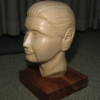Outlining the design - what carvers call 'lining in' - with the V tool is a normal way of starting a flat relief carving and in this lesson I show you how to go about it.

| 02 November 2015 18:42
Ton - Yes, a veiner is certainly a substitute for the V tool when lining in. I prefer the V tool because I can angle it out to give me an upright 'wall' to the carving and a sharpen bottom to the cut, especially when using a bigger tool - rather than any issue of control. At the end of the day, try both and keep to the one you prefer?

| 02 November 2015 16:28
Hi Chris, you use a v-tool for this kind of work, is a veiner an alternative? Which of the two is more efficient and easier to control a constant depth with according to you?
Kind regards, Ton

| 09 December 2013 19:42
David - An important technique for you here: Use your blade hand to resist the forward push. Excert a braking effect. Stop cuts: well done. If I even think I might need one I put it in!

| 04 December 2013 19:12
Hi, At time 2:20 while carving inside zero I did a small stop cut at top and bottom of. First time I cut right through bottom of zero :<( Stop cut seemed to help me not going to far. I use them a lot. Have a great day!

| 01 July 2012 13:03
Andy - You are probably right and I am sensitive to the grain direction. It's easy to tear wood fibres into the letters and spoil them so, yes, no doubt I go easier in some areas than others without really being aware or it. You can do the whole lining in and lowering in a gradual series of 'passes' if that's safer. The wood is Oak, by the way; a good outdoor timber.

| 28 June 2012 04:03
It appears that you make less aggressive cuts in certain places. Is that simply because of the curve (such as inside the 5), or does it also have to do with the direction of the grain at those places? (Did you say which kind of wood you are using?)